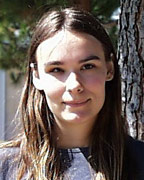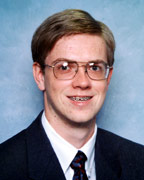Two Young Physicists Honored with 2002 Apker Award
 |
|
Kathryn Todd
|
 |
|
Robert Wagner
|
Two promising undergraduate physics majors have been awarded
the 2002 Apker Award. Robert E. Wagner of Illinois State University was
honored for his thesis entitled, "Intense Laser Physics Theory."
And Kathryn Todd of the California Institute of Technology was honored
for her thesis entitled, "Studies of Two-Dimensional Electron Systems."
The Apker Award is given annually by the APS for physics
research done by an undergraduate. The award was first given in 1978,
and in recent years has been divided into two categories, depending on
whether the institution has a PhD granting program or not. The winners,
who will receive $5,000, were selected by a committee from among the seven
finalists (see APS
News, November 2001).
Wagner quickly distinguished himself at Illinois State as
a gifted physics student, joining the laboratory of the Intense Laser
Physics Theory Unit immediately after graduating from high school, learning
a new computer language in less than a week. He then developed from scratch
a computer simulation program to simulate the relativistic dynamics of
atoms in strong laser and magnetic fields, resulting in his first peer-reviewed
publication. His codes are still used by the group to explore theoretically
novel mechanisms to generate new light sources exploiting resonance last-atom
interactions.
Using his computer skills, Wagner has undertaken numerous
research projects, including the exploration of a hydrogen atom in a laser
field. He later added a strong, static magnetic field to the system, and
found that the probability density function for the electron - which is
initially the ground state of hydrogen - evolves over time to form a ring-shaped
structure later dubbed a cycloatom. His most recent project concerns classical
and quantum modeling of an electron-electron collision, with the objective
of gaining a better understanding of the classical approximation in a
two-electron system, which he hopes to apply to the study of a two-electron
cycloatom.
Although just beginning his senior year, Wagner has presented
more talks, published more papers and won more awards than any previous
physics major, according to departmental chair Richard Martin. He has
given 11 conference presentations and contributed to nine peer-reviewed
publications, including a Physical Review Letters article on his
development of a new Internet-based visualization software package that
can generate 3D computer animated movies, which was featured in Physical
Review Focus as well as Science News.
He has twice been selected to give invited talks at the
APS Division of Atomic Molecular and Optical Physics' undergraduate research
symposium, and presented a paper on high harmonic generation in ionization
of magnetically dressed atoms at the APS Centennial Meeting in 1999. Wagner
describes the past three years of research as "a very exciting and
rewarding part of my undergraduate education" adding that he plans
to pursue a career in physics. "I am looking forward to the new challenges
offered by a physics graduate school."
Todd's thesis consisted of two main experimental research
projects, both involving the physics of two-dimensional systems in semiconductor
heterostructures. In the first, she studied the mobility of a 2D electron
gas confined to an interface between gallium arsenide and an alloy. In
such systems, the electrons are typically donated by silicon atoms deposited
in a thin sheet some distance away from the interface on the alloy side.
Todd added a narrow quantum well between the dopant sheet and the material
interface in order to add a second layer of 2D electrons which could screen
potential fluctuations of the donors. She then employed theoretical modeling
to produce predictions of the electron densities in the quantum well and
heterointerfaces as a function of various physical parameters.
In her second project, Todd examined the tunneling current
that flows perpendicularly between two parallel 2D electron systems in
a symmetrically doped double quantum well system. When a large magnetic
field is perpendicularly applied to the 2D planes, tunneling at low interlayer
voltages is heavily suppressed. Todd sought to examine this suppression
and determine the exact shape of the nonlinear current voltage (I-V) characteristic
at very low voltage. She succeeded in manufacturing tunnel junctions and
measured the tunnel current down to values 100 times smaller than the
research group had done in the past, concluding that the suppression effect
deep in the gap was less rapid than it appears at higher energy. She is
still pursuing the project, hoping to obtain a quantitative result for
I-V deep in the gap.
James Eisenstein, her thesis advisor at CalTech, says he
has watched Todd "mature from an inquisitive young undergraduate
into an accomplished laboratory scientist," noting that in order
to arrive at these scientific conclusions, she performed all aspects of
the experiments and analyses herself, "at the level expected of an
experienced graduate student." These included optical lithography,
wet etching, thin film depositions, and low temperature, low noise electrical
measurements. Todd is currently attending graduate school at Stanford
University to pursue a PhD in physics.
Copyright 2001, The American Physical Society.
The APS encourages the redistribution of the materials included in
this newsletter provided that attribution to the source is noted and the
materials are not truncated or changed.



